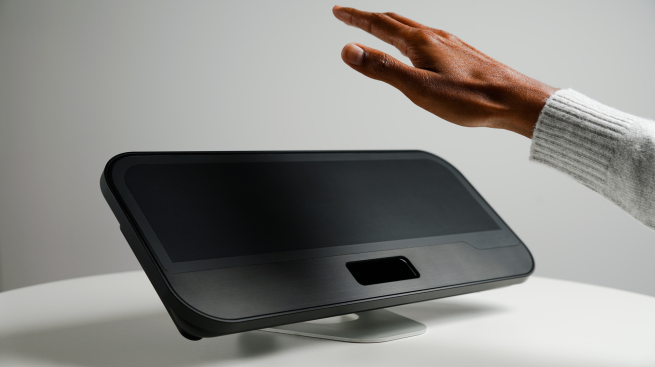Ultrahaptics is at the forefront of a new technology called “haptics.” Greg Patrick, Vice President of Digital Signage at Ultrahaptics, spoke with Mel Stott about how his company is applying haptics technology to out-of-home advertising.

Ultrahaptrics mid-air touch for DOOH advertising
Could you please define ‘haptics’ for us.
“Haptics” means anything relating to the sense of touch. It is the science and the technology of transmitting and understanding information through touch.
How does your technology work?
We use ultrasound to create the sensation of touch in mid-air. We use an array of small speakers to project sound waves directly onto a user’s hands. When these soundwaves are combined at a targeted focal point, they create enough pressure to be felt on the user’s skin.
What does a person experience when exposed to a mid-air tactile sensation?
The ultrasound waves interact with the nerves in the hand and generate a tactile sensation that we perceive as touch, or something touching our hands. Our technology manipulates the ultrasound and creates different sensations and effects in a variety of strengths. For example, we can create the sensation of bubbles, waterfalls or waves, lightning and more.
How might one come in contact with your product?
From a digital signage perspective, it could be at malls, airports, cinemas, or any large public spaces. You could also experience our technology in theme parks, in cars or even at home. Our goal is to enable the user to interact with their surroundings in a more natural way – using hand gestures and mid-air touch.
How do you apply haptics to DOOH advertising?
We see haptic advertising bridging the gap between offline and digital, offering tangible, tactile and emotional brand experiences with all the benefits of digital signage technology: flexible, interactive, quantifiable, cost-effective and targeted.
Touch, in particular, creates an emotional connection between buyers and sellers. When you touch something, it triggers an emotional connection with the item, i.e. if you can feel it, you are more likely to want it.
By incorporating haptics into out-of-home advertising, we can create a stronger connection between the consumer and the brand, product or message. Consumers are already seeking out more intuitive and seamless interaction in their daily routine. Haptics provides the opportunity for brands to stand out from the crowd and increase product engagement.
Have you worked with any brands on haptic campaigns? If yes, can you share an example?
We recently created three interactive movie posters for Shazam, La Llorona and Detective Pikachu. These interactive installations were placed in the Regal Theater lobby at L.A. Live, for movie-goers to experience the next-generation of movie posters. They could wield superhero powers, play with haunted water and feel Pikachu’s lightning attack right on their fingertips.
We’ll be releasing the data from the project soon, but the feedback and insight so far has been really impressive. We’re also working with big brand names on other projects, but as you can imagine, they like to keep things under wraps.
Are you able to measure the impact of haptics-enabled campaigns?
Using haptics in digital signage is all about grabbing attention, creating engagement or increasing dwell time. Those are all elements we can measure and provide as data back to clients to demonstrate impact. Our test data so far indicates that adding haptics really does provide added engagement that can boost the bottom line:
- 73% increase in purchase intent
- +56 increase in net NPS (Net Promoter Score)
- 50% increase in interaction time
What is the future for haptics in advertising?
Our world is becoming more connected by the day. With the development of 5G and IoT, devices have the power to be seamlessly connected with one another, and to the consumer. Access to information will be better but the expectation for it to be seamless, intuitive and natural will be greater.
In order for us to succeed in this new advertising world, we must think multi modal and multi-sensory. Haptics is just one immersive technology the ecosystems should consider. To advance in this increasingly complex digital world, we must go back to the very basic and natural way of how people like to engage with products and brands – by seeing, by feeling – and look at how those experiences can be enhanced by technology. Proximity to purchase will still be important but the type of information and how we disseminate it will become more relevant – through touch, voice, gesture or other.
We need to trigger an emotional reaction, just like touch gives us the feeling of emotional ownership. We need to humanize the experience in this new environment.
You can find out more about haptics and DOOH in our whitepaper.
To learn more about Ultrahaptics, visit their https://www.ultrahaptics.com/
This is a DPAA-sponsored feature. For info about DPAA, go to: https://dp-aa.org/
To keep track of ALL important digital signage and DOOH news, subscribe to our free Editors’ Picks newsletter here.